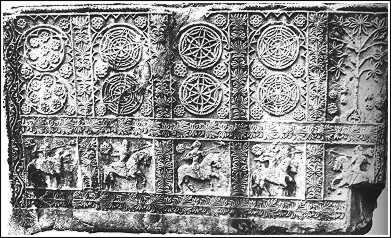Serbian Medieval History
Stjepan II Kotromanic, Ban (1314-1353)
The isolated and mountainous Dinaric region of Bosnia emerges in the 12th century as a sort of "no man's land", intermittently claimed by Hungarian and Byzantine rulers, but populated chiefly by Serbo-Croatian stock and administered by a relatively independent local nobility, the most prominent of which held the title of "ban". Some more information comes from the turn of the 12th century and the time of ban Kulin, in the context of his resistance to political and ecclesiastic pressures from the Vatican and Hungary, and cordial relations with the Dubrovnik Republic; but data remains scarce for the next century, though the political pattern appears similar.
Documented changes are evident with the Bosnian ban that was to found of a more cohesive medieval state, Stjepan (pr. STYE-pahn) II Kotromanic. His father, ban Stjepan I Kotroman, was married to king Dragutin Nemanjic's daughter; this direct Nemanjic lineage would enable his son to claim dynastic continuity at later times of turmoil and trouble in the central Serbian state.
Until 1322 Stjepan lived in the shadow of the powerful Croatian noble family Subic. With Hungarian support he secured his power over the entire state, maintaining good relations with the Hungarian court after the eventual downfall of the Subic brothers. Taking advantage of strife among the Croatian nobility within the Hungarian state, he extended his boundaries westward (Neretva river marshland), and gained control over the larger part of Zahumlje. At the same time, Bosnia grew in strength internally, especially in mining and trade; in fact, the growth of mining in the area was such that by the early 15th century Serbia and Bosnia accounted for more than one-fifth of Europe's silver output. Stjepan was the first Bosnian dynast to mint money - silver dinars engraved by Ragusan die-cutters based on models from czar Dusan's Serbia. However, the state structure needed to support this was very loose - more so than in Serbia - and largely still dependent on the personal loyalty of the magnates to the central ruler.
Despite the staunchly Catholic stance of Bosnia's overlord Hungary, the state remained relatively multiconfessional, with no state Church and three Christian communities generally coexisting: Orthodox in the east (mostly Podrinje and Hum regions), the rest divided roughly by Catholics in the urban, and followers of the so-called Bosnian Church in rural areas. Ban Stjepan gave personally a certain reflection of this: born Orthodox, he yielded later to papal pressures and converted to Catholicism, but displayed institutional tolerance of the Bosnian Church. Incidentally, much has been speculated on the nature of this religious organization that was to disappear with the Bosnian state in the 15th century, and it is typically assumed that these were members of the dualist Bogumil heretic sect that migrated under persecution westward through the Balkans. Some modern scholarship challenges that - relating them more to independent-minded and Slavic-oriented Catholic monastic orders - and citing the doctrinal orthodoxy of their few surviving texts. Some of these - e.g. Divos' Gospel and Hval's Collection, with their masterfully illuminated liturgical Cyrillic texts - represent remarkable, but unfortunately rare, monuments of the Bosnian Church.
Stjepan's achievements, though suspended for a while following his death, were later to be revived under his able son Tvrtko.
STECAK

A richly decorated "stecak" (pr. STE-chak) originally from Donja Zgosca (Sarajevo National Museum). One of the most original and characteristic legacies of the medieval Bosnian culture were these elaborate tombstones, which permeated all religions in the land. Their most prolific generation began probably late in the reign of Stjepan Kotromanic, and continued for about the next century and a half, into the early Ottoman occupation. Many puzzles still surround the background and content of these works, but their blend of Eastern and Western influences and their fresh, unpretentious treatment of a broad range of themes from secular to pious remains fascinating to date.
Others
More Information
BLAGO Content
While the content of the BLAGO Fund collections is free to use, there are also some restrictions on commercial use and proper attribution of the material. Follow the links below for more information.
> BLAGO Collections License
> Image Request
BLAGO Fund also accepts the contribution of material. Please contact us with any material you wish to publish on our website.
Contact
BLAGO Fund, Inc.
PO Box 60524
Palo Alto, CA 94306
USA
info@blagofund.org

